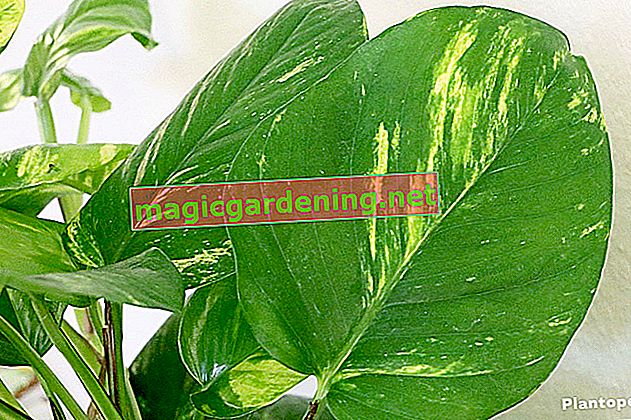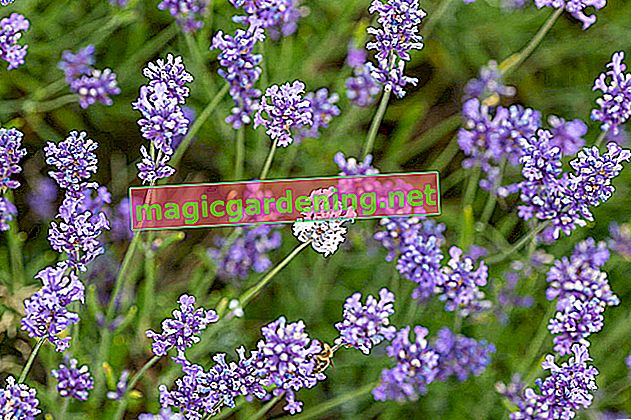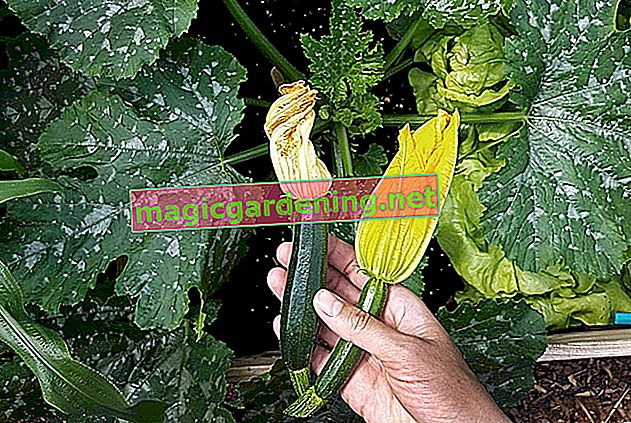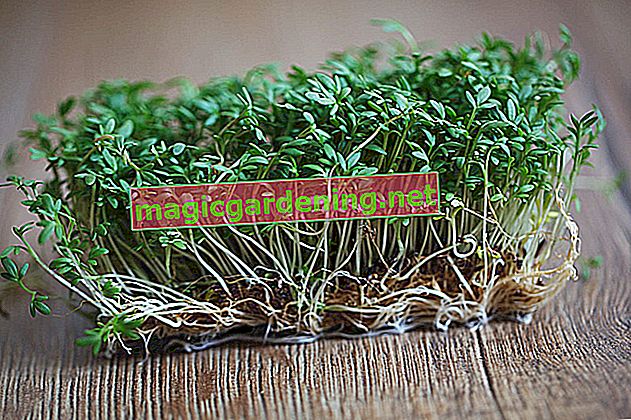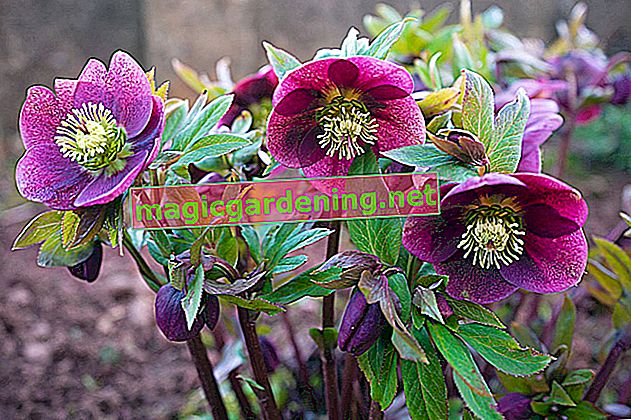
the essentials in brief
- Raw acorns are not edible due to their high content of tannins
- Roasted acorns, however, contain many vitamins, minerals, and valuable carbohydrates and fats
- Coffee and bread can be made from roasted acorns
- If you don't collect the acorns until late winter or early spring, most of the tannins have already been washed out
Can you eat acorns?
Acorns are poisonous and edible at the same time. Contrary to popular belief, acorns do not contain hydrocyanic acid. Nevertheless, a considerable amount of toxic tannins, especially tannic acid, causes severe discomfort after eating raw acorns. In return, acorns are rich in healthy vitamins and minerals. Our grandparents appreciated the high nutritional value during the hunger years after war and poor harvests. 100 grams of acorns contain a whopping 387 calories, as well as 40.75 grams of carbohydrates and 23.86 grams of fat.
also read
- Are acorns really poisonous?
- Acorns are the fruit of the oak tree
- Lupins - robust all-rounders for the garden
Acorn bread, pasta made from acorns and acorn coffee helped our ancestors through difficult times with their nutty, aromatic taste. For countless children, acorn flour was the last bastion from starvation. Natural food was forgotten for a long time and is now experiencing a renaissance.
Making acorns edible - how does it work?
Worms in acorns make the fruit basically inedible. First check collected or purchased acorns for worm infestation. A clear indication are tiny drill holes in the shell. Fill all remaining acorns in a bucket with water. What floats on the surface of the water is sorted out as worm-eaten. How to make the remaining acorns edible:
- Spread acorns on a baking sheet
- Roast in the oven at 150 ° for 20 minutes
- Peel the roasted acorns and put them in a cloth bag or laundry net
- Immerse the bag in a bucket of water for 4 days
- Change the water daily until it remains clear
- Dry the detoxified acorns in the oven at 100 ° on a baking sheet
- After drying, grind finely in a meat grinder, coffee grinder or blender
The step-by-step treatment of roasting, peeling, soaking and drying removes the toxic tannins from acorns. Whether you actually grind all the nuts after they have dried is up to your personal decision. Pamper your loved ones with roasted acorns as a very healthy snack in a cozy atmosphere.
YoutubeRecipes for acorn bread and acorn coffee
You can use the finished acorn flour to prepare a variety of dishes, such as pasta or bread. You are also holding the basic ingredient for the legendary acorn coffee, also known as muckefuck. The two recipes for acorn bread and coffee made from acorns may fire your culinary imagination:
Acorn Bread - Ingredients and Preparation
- 500 g acorn flour
- 500 g whole wheat flour, optionally rye or spelled flour
- 25 g yeast
- 750 ml of lukewarm water
- 2 tbsp salt
- 1 tbsp soft butter or oil
Mix the flour and salt. Dissolve the yeast in water and fold in. Add butter or oil. Stir in lukewarm water until a fluffy, loose batter is formed. Put the dough in a bowl and let rise in a warm place for 2 hours. Knead the risen dough again and shape it into a long bread. Preheat the oven to 220 ° top and bottom heat. Place the dough on a floured baking sheet and slide it into the middle rack. After 30 minutes lower the temperature to 190 °. Make a baking test every 30 minutes: pierce wooden sticks and continue baking as long as the dough sticks to it. A dry stick indicates the end of the baking time.
Acorn Coffee - Ingredients and Preparation

- per cup of Muckefuck: a bowl of acorn flour
- Coffee filter with filter paper
- Sugar, cinnamon and milk to taste
If you have processed acorns into flour, the preparation does not differ from conventional coffee beans. Boil water bubbling up. Fill the filter bag with two heaped teaspoons of acorn flour and slowly pour the hot water over it. Add sugar, cinnamon and milk to give acorn coffee a special touch. The result is an aromatic hot drink that is good for your digestion and has a blood pressure lowering effect.
What do acorns look like?
Different oak species and varieties thrive in forests, parks and gardens, which can be easily distinguished by their acorns. The common oak and grape oak as well as the American red oak are the most common. Egg-shaped acorns with a brown skin and a length of 2 to 3 cm hang on these trees in autumn. Characteristic is a fruit cup that envelops up to a third of each acorn as long as it is still green and immature. Ripe, brown acorns either fall to the ground with their fruit cups or they separate from the cup beforehand. Meaningful pictures of acorns of the different oak varieties can be viewed on Wikipedia or the tree portal.
When are acorns ripe?
In autumn there is a lot of activity around oak trees, because at this time of the year the fruits are ripe. From September brown acorns fall to the ground in droves. During the ripening period, the smooth-skinned nuts are green and partially enclosed in a fruit cup. As long as acorns are hanging on the tree, they are not ripe. A hunched back is unavoidable when you want to collect fully mature acorns.
The best time to collect depends on what you plan to do with acorns. For handicrafts and decorating, an oak tree gives you the most beautiful fruits in autumn when the pods only have brief contact with the damp ground. If you are preparing aromatic dishes or invigorating Muckefuck from acorns, late winter and early spring are the ideal times of the year. By then, snow and rain had naturally washed out a large part of the tannins and made acorns edible.
What can acorns be made of?
When the days get cooler and family life moves to a warm home, acorns are ripe. This makes the handy brown nuts the ideal material for craft ideas and imaginative natural decorations. Children and adults with an affinity for handicrafts really appreciate the smooth shell of acorns, which is wonderful to paint. The following table would like to inspire you with a colorful array of creative suggestions for what can be made of acorns:
| Acorns | Tips |
|---|---|
| color | with acrylic colors |
| stick on | with colored or white wool |
| make funny figures | with chestnuts, pine cones, matches |
| arrange | as a decoration in an autumn bowl with a candle |
| crochet | Crochet lifelike acorns from wool |
| to paint | paint from a coloring page or freehand |
| line up | tinker with cord as an autumn garland |
| Paint the acorn fruit cup | Color in the fruit cups |
| felting | Make felt balls with acorn fruit cups as hats |
No craft ideas - what to do?

Making figurines out of acorns is great fun for the whole family. If you just don't want the craft ideas to bubble, take a look at the social networks. Youtube, Instagram and Pinterest are full of creative variations and instructions for all ages.
The popular magazine Landlust devoted an entire issue in 2010 to Eichelschmuck, including instructions for crocheting acorns. Free coloring pages for children on the subject of acorns can be found in many places on the net. For example, child-friendly templates can be downloaded from gratis-malvorlagen.de.
What can you do with acorns?
Acorns in abundance arouse the passion for collecting and raise the question of what you can do with the spherical fruits. Instead of carelessly letting the valuable nuts rot on the ground, there are a wide range of sensible options for useful uses. The following list would like to inspire you to benefit from the wealth of an oak tree:
- Plant in a pot with potting soil, allow to germinate and grow a tree from it (see instructions below)
- process into flour for bread, pastries or noodles, roasted nuts, Muckefuck
- collect and hand in in kindergarten and elementary school as handicraft material
- Hand it in at Haribo in October in exchange for gummy bears
- collect and sell to foresters, zoos or animal parks as fodder for roe deer, deer and martens
- Let dry and drape as a natural decoration with chestnuts, pine cones and colored leaves
Sowing acorns on your own in the forest is of course not an option. The use of acorns as seeds is subject to the Forest Reproductive Material Act. To ensure that sown oaks bring the right genome with them, only seeds from certified stocks may be planted in public forests and parks.
Tips
Acorns against woodworms are a popular home remedy for disinfecting individual pieces of furniture from the maggots. For this purpose, numerous acorns are distributed all around. Regular knocking, rattling and shaking makes life hell for the pests in the wood. In search of exile, the woodworms move to the acorns and can be disposed of.
Which animals eat acorns?
When ripe acorns patter to the ground in autumn, a time of abundance begins for many forest animals. Acorns have long since served their time as a human staple food for times of need or fattening feed for domestic pigs, so that wild animals can draw on the full from September. For some stable dwellers, acorns provide a little variety on the menu. The following table summarizes which animals like to eat the crunchy nuts of an oak tree:
| Forest animals | Stable animals |
|---|---|
| deer | Domestic pig |
| deer | goat |
| wild boar | Rabbits |
| squirrel | Mice |
| Badger | hamster |
| Hare | horse |
| Wood mouse | |
| Marten, pine marten | |
| jay | |
| great spotted woodpecker |
For all domesticated animals, acorns are a double-edged sword as food. In small quantities, the fruits prove to be a healthy addition to the menu. This also applies to the sensitive stomach of horses or hamsters. However, excessive consumption causes symptoms of intoxication such as colic, diarrhea or vomiting. Buying acorns as feed only makes sense for livestock in individual cases. An exception applies to pig breeds that are fattened for fine oak ham and that tolerate acorns as feed. A prime example is an Iberian pig breed that is fed almost exclusively on acorns. Spanish ham delights gourmets all over the world with its pink, fine, fibrous structure and unmistakable taste.
The best ham grows on oaks.
Oak pulling from acorns - how does it work?
Acorns are very slow to germinate. It is therefore a time-consuming undertaking to grow a tree from acorns. The project is still worthwhile, because an oak tree can live up to 1,000 years and heralds the ambitious gardener who brought it to life for many generations. As a cold germ, the seeds first have to go through a cold phase, known as stratification. Only then is the germination aroused for successful cultivation. The following instructions explain how to grow a splendid tree from acorns:

Collect, examine, stratify
Due to a high failure rate of more than 50 percent, we recommend harvesting a larger number of acorns and subjecting them to stratification.
- best time to collect: September and October
- Remove brown acorns with undamaged skin from the fruit cup
- fill in a bag with damp sand or sawdust
- Store in the vegetable compartment of the refrigerator for 6 to 8 weeks at 0 ° to 4 ° C
- check regularly for slight moisture levels and the first signs of germination
Sowing and growing
Regardless of whether an acorn germinates or not, sowing can be carried out after 6 to 8 weeks of stratification in the following steps:
- Fill 10 cm seed pots (€ 14.90 at Amazon *) with seed soil or coconut soil
- Plant an acorn in each pot with the radicle or the narrower end down in the substrate
- Sieve seeds thinly with soil, press lightly and water
- keep it constantly slightly moist in the bright, not full sun window seat
- From a height of at least 20 cm, plant in a bed in a light, sheltered location
The chances of success increase significantly if you look for sprouted acorns in the forest in spring. These specimens have passed the cold phase naturally and demonstrate their willingness to germinate with the first leaves. Dig up a seedling and plant it in poor, loose, peat-free soil with the small taproot facing down.
Digression
Lots of acorns as a winter forecast?
The centenary calendar shows that many acorns predict plenty of snow for the winter according to farmers' rules. According to this, squirrels should store extra large food supplies in anticipation of a harsh winter, which Mother Nature supplies in appropriate quantities. This wisdom is on shaky ground for several reasons. Squirrels have no clairvoyant skills and cannot forecast the weather for two months in advance. Furthermore, the number of blossoms from the previous year determines how many acorns there are to collect this autumn. Last but not least, an oak tree has to get through spring safely, because late frosts in May destroy most of the blossoms.frequently asked Questions
Are acorns nuts?
What are acorns anyway? This question does not only go through the minds of children during autumn walks in the forest. In fact, acorns belong to the nuts, more precisely to the nut fruits. A woody pericarp usually encloses a single seed. Only when the shell around the individual seeds has completely hardened does it fall to the ground as a closing fruit. As a result, acorns play in the same league as familiar nuts such as hazelnut or walnut.
When do acorns fall?
Under normal conditions, ripe acorns fall to the ground from September. When exactly a seed fall starts depends largely on the weather of the year in question. In mild regions, the tree slice of an oak tree is covered with ripe acorns from the beginning of September. In the cold north, acorn lovers usually have to wait until the end of September for the first brown nuts to fall.
Are goats allowed to eat acorns?
Coarse feed is essential for a good rumen function in a robust goat stomach. Lignified parts of plants are therefore an important part of a healthy diet. This also includes ripe acorns. The versatile ruminant stomach of a goat easily processes the tannins it contains. Only brown, ripe acorns may be fed, as green fruits can be poisonous. However, the amounts eaten should be kept within limits due to the high calorie and carbohydrate content so that the animals do not become fat.
Our dog eats acorns. Can the animal get poisoned in the process?
You are right to fear, because large quantities of acorns eaten can cause poisoning. Acorns contain a high concentration of tannin. This tanning agent can cause abdominal pain, diarrhea, vomiting, and even kidney failure in dogs. If your darling devours an acorn or two while walking in the woods, there is no need to panic. Small dogs should of course not eat more than five acorns. Aside from the poisonous tannin, there is a risk of intestinal obstruction if nuts are swallowed without being chewed.
Do squirrels eat acorns?
Acorns are not at the top of the squirrel menu. The bitter substances it contains spoil the furry climbing artists' appetite. Squirrels prefer to plaster beechnuts, hazelnuts, chestnuts and berries. If the small stomach growls a lot, acorns are still eaten. Squirrels use fruits that have been lying on the ground for a long time, so that the rain has largely washed out the bitter substances.
Should I remove acorns from the lawn and compost in the fall?
Acorn-covered lawn is not a cause for concern. The nuts cannot cause permanent damage to the green space. Of course, it cannot be ruled out that lively tree seedlings will sprout in some places next year. It therefore makes sense to remove acorns from the lawn in autumn. You can simply collect small amounts by hand. You can easily vacuum up a thick carpet of acorns with a leaf vacuum or a special acorn collector. Acorns are not suitable for composting. You can give larger quantities to the local forester as rich winter feed for deer.
Tips
With a close-meshed net you can collect acorns in premium quality. Spread out under the tree in good time, the harvest net prevents direct ground contact with leaf litter and rotten acorns from the previous year. Before this, the ground is cleaned of old branches, stones and leaves. After the seeds are dropped, the net is brought in promptly so that as little wet leaves and debris as possible fall onto the valuable acorns.


